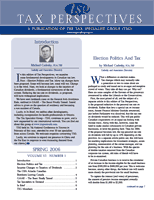
PDF Format
 Issue Contents Issue Contents
 All Issues All Issues
Spring 2006
Volume 6, Number 1
The information in Tax Perspectives is prepared for general interest only. Every effort has been made to ensure that the contents are accurate. However, professional advice should always be obtained before acting and TSG member firms cannot assume any liability for persons who act on the basis of information contained herein without professional advice.
GAAR — The Beast Finally Tamed
By Grace Chow, CA, TEP
Cadesky and Associates LLP (Toronto)
The General Anti-Avoidance Rule (GAAR), once a fearsome beast, has finally met its match. In two decisions of the Supreme Court rendered in 2005 (Canada Trustco Mortgage Co. v. Canada and Mathew v. Canada), the beast has finally been tamed. GAAR has long been touted as the ultimate fighter in the taxman's corner. It is a trump card which changes the rules of the game, after the game has been played. Here is how GAAR operates. A transaction complies with the Income Tax Act ("Act") to produce a result determined by specific provisions of the Act. However, the result is not what the taxman expected. By saying the transaction is abusive, it is re-characterized to produce the result the taxman wants, trampling over specific provisions of the Act which operate to the contrary. Small wonder nobody likes GAAR, except the taxman. According to the Supreme Court, the application of GAAR works as follows. First, determine if a transaction has resulted in a tax benefit. The transaction will be an avoidance transaction, unless carried out for bona fide business reasons, other than obtaining the tax benefit. In most circumstances when GAAR is applied, a taxpayer will not be able to prove that a transaction is not an avoidance transaction. The onus of proof so far rests upon the taxpayer. Now comes the interesting part. GAAR may be successfully applied only if the tax avoidance transaction has resulted in a misuse or abuse of the Act. While there may be tax avoidance, is it "abusive" tax avoidance? The onus here is on the Minister to prove abuse. To do so, the Minister must show a clear policy intent within the framework of the legislation, and an abuse of that policy intent through the transactions carried out. Given the complexity of the Act, and the haziness surrounding the intent of legislation, often modified through numerous drafts and amendments, with rules, exceptions to the rules, and exceptions to the exceptions, this is not a simple task. A number of extracts from the Supreme Court's judgment in these cases are worth reproducing. "The GAAR was enacted as a provision of last resort in order to address abusive tax avoidance, it was not intended to introduce uncertainty in tax planning." "Parliament sought to address abusive tax avoidance while preserving consistency, predictability and fairness in tax law and the GAAR can only be applied to deny a tax benefit when the abusive nature of the transaction is clear." "Courts have to be careful not to conclude too hastily that simply because a non-tax purpose is not evident, the avoidance transaction is the result of abusive tax avoidance." "Parliament intends taxpayers to take full advantage of the provisions of the Act that confer tax benefits. Parliament did not intend the GAAR to undermine this basic tenet of tax law." The Supreme Court made it clear that it is the Tax Court of Canada which should determine whether GAAR is applicable in any given instance. It did not take long for the Tax Court to decide, in Evans, L. v. The Queen, that GAAR was not applicable to a clever and circuitous plan to extract funds from a corporation virtually tax free, utilizing, among other things, income splitting with other family members. Despite the fact that CRA found the scheme "offensive", they were nevertheless unable to convince the Tax Court that GAAR should be applied. CRA could not clearly articulate the abuse. This case represents a fundamental shift in thinking. Consider this: CRA finds a tax plan offensive, meaning that it produces a result which they do not like, did not anticipate, and which is unduly beneficial to the taxpayer. CRA concludes that the plan is abusive, and should be struck down on the basis of anti-avoidance provisions and, if specific ones cannot be found, on the basis of GAAR. An unduly beneficial tax result cannot be allowed to stand, says CRA. That should be enough to convince the Court that applying GAAR is justified. But not so, said the Supreme Court! From the taxpayer's perspective, one would argue that the tax plan complies with the letter of the law in every aspect and produces a result specifically sanctioned by the Act. Even if the end result is unduly beneficial, that is the way the system works. If Parliament had intended a different result, they could have legislated accordingly. Now we enter the domain of abuse. The Supreme Court has clarified how this is to be handled. You do not look at the end result, but at the specific provisions of the Act that produce the end result. The onus is on CRA to show that one (or more) of these provisions has been used for a purpose contrary to its intended purpose, to produce an unintended result. In case of doubt, the taxpayer wins. While the difference between these approaches may seem small, it is nevertheless fundamental. CRA can no longer invoke GAAR merely because they do not like what was done, or the end result.
| 




